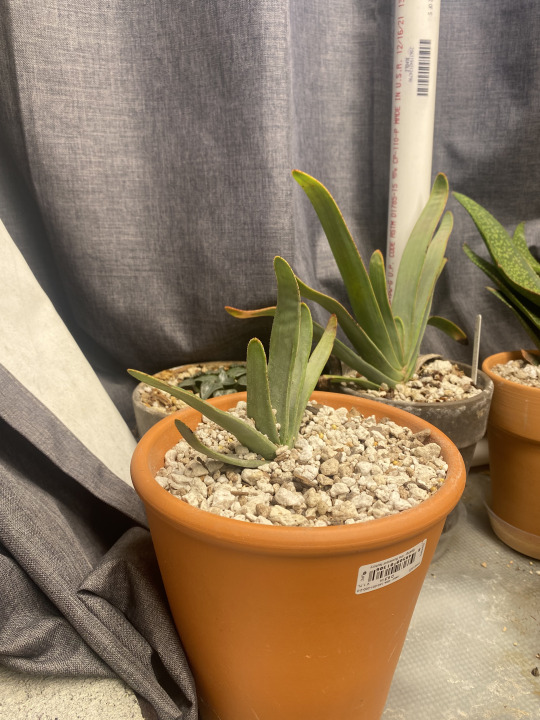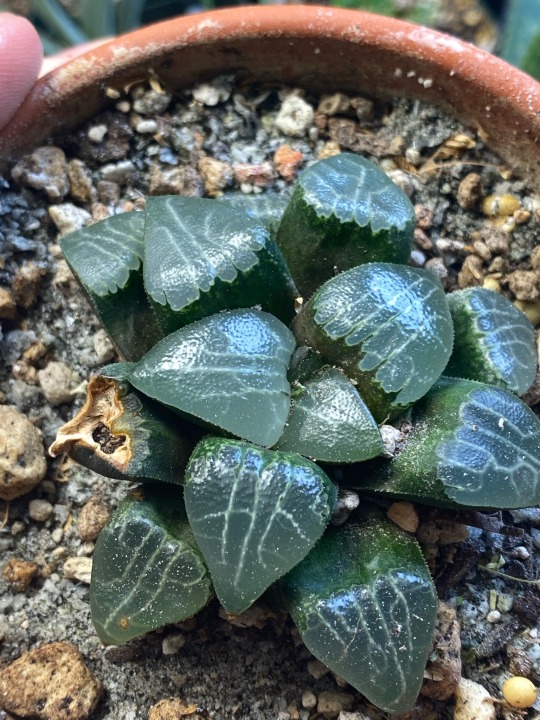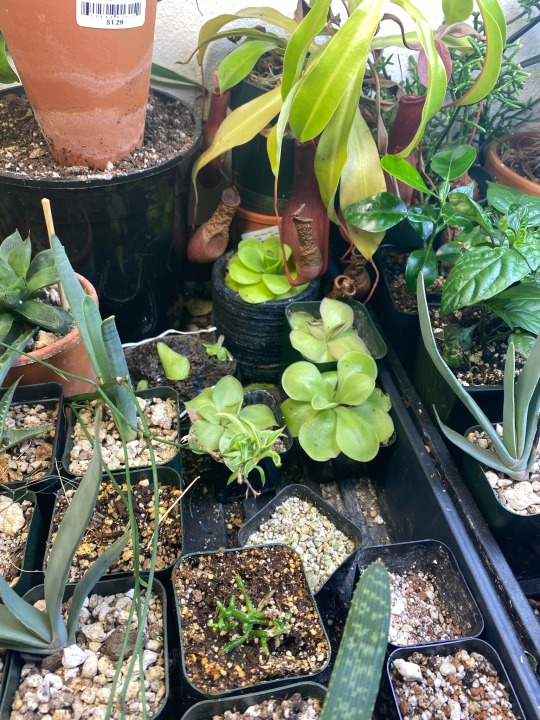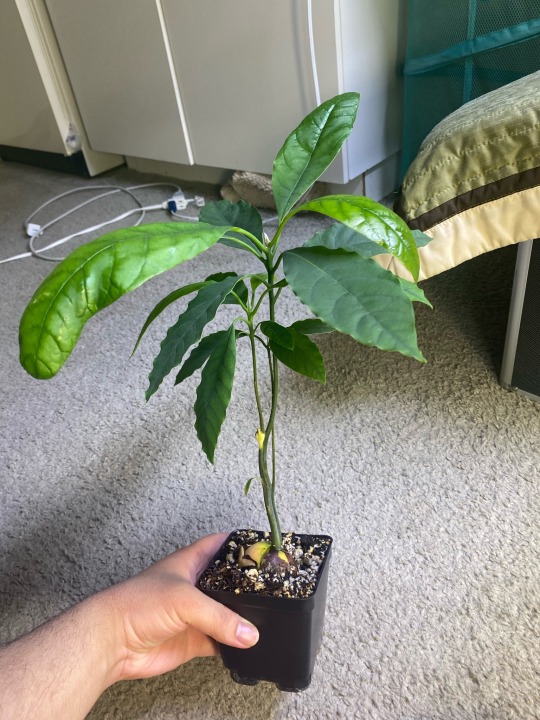#gonialoe
Text


Went to the cactus and succulent society’s annual Volunteer Park Conservatory sale and got myself some new friends! I got sea plantains (Plantago maritima), Lewisia columbiana, Gonialoe variegata (my friend sold me this! I have this species but one isn’t looking too good and I want a breeding pair), and some free Stapelia grandiflora cuttings!
I donated one of them to Chocolati and told the staff that its name is Spubsy and it will be their new coworker to replace the deceased Fatsia japonica that was formerly in that pot.
22 notes
·
View notes
Text










Plants update. Ananasso the Gonialoe variegata and one of the Echeveria are flowering, as well as a couple other plants. The winter was warm (except for the last week) and almost every plant kept growing, to the point some needed a new pot.
5 notes
·
View notes
Photo



Gonialoe variegata, Oudtshoorn | ゴニアロエ・バリエガタ
寒くて目覚めた朝。暖房設備なく隙間風入る安宿のせいと思ったが、外に出ると車窓に霜。土に霜柱。吐く息が白い塊になってしばらく残る。こわばった体をあたためるべく宿のまわりを歩いていたら黒い植物。バリエガタってこんな色になるんだ。日本では見たことがない色。蕾もち。
7 notes
·
View notes
Photo

gonialoe variegata.
#plants#aloe#succulents#plantblr#gonialoe variegata#partridge breast aloe#window garden#aloe plant#aloe variegata#cacti and succulents#my plants#los-plantalones
93 notes
·
View notes
Text

Gonialoe variegata
Tiger Aloe
72 notes
·
View notes
Text
3 - 9 February 2020
This week the lawn was mown for the first time this year. We’re raising bed borders of stone which have sunk over the years, which look great when done. I’m slowly continuing my work on the Galanthus collection. Susyn, our taxonomist, was in so I spent Tuesday with her. Wednesday I was able to use the herbarium and the old card catalogue to solve some issues I have found recently while uploading the digital images of the Florilegium’s paintings. There was a painting of a Pelargonium cucullatum that didn’t seem to exist in the garden at the time of paining, and sure enough, using both those sources, I found some accessions that hadn’t been put on the database.
Thursday I assisted in the judging of last year’s paintings by members of the Florilegium to see if they were accurate enough to be added to the collection. As usual, most were, and will be fantastic contributions to our every growing collection.
This has been a busy weekend too. Friday after work I headed north, to Watford to visit Atif. We hadn’t seen each other in over eighteen months. We made a delicious meal and just enjoyed catching up. Saturday I met up with Jeffrey, visiting from Amsterdam to attend a Madonna concert at the Palladium. We enjoyed the afternoon drinking and catching up, and will find a weekend to meet up again in Valencia this year. Then I met Pasquale at the Vaults, a performance space under Waterloo station. We were disappointed with the performance. Then we walked into Soho for a delicious Indian meal which raised our spirits.
Today I braved the gale force winds to go to Brixton to lunch with Jem and Dèjì. I entertained the idea of mowing the lawn at home this morning in the blustery weather, then the rain moved in. The Galanthus I planted last year are looking good. A few other things are suffering from not enough sunlight during the summer. I missed my opportunity last week to add to the Galanthus in the garden, so that will have to wait another year.
Plant of the week
Asphodelaceae Gonialoe variegata (L.) Boatwr. & J.C.Manning

common name(s) - partridge breast aloe, kanniedood aloe, tiger aloe
synonym(s) - Aloe ausana Dinter; Aloe punctata Haw.; Aloe variegata L.; Aloe variegata var. haworthii A.Berger; Tulista variegata (L.) G.D.Rowley
conservation rating - none
native to - Namibia and South Africa
location - conservatory glasshouse, accession 2014-0644
leaves - stiff, fleshy, pointed dark green, attractively-banded with white
flowers - racemes of tubular salmon-red flowers in summer
habit - an evergreen perennial to 200mm, forming a clump of rosettes
habitat - generally grows in rocky terrain and outcrops where they may grow between boulders, but may also grow in soils with sharp drainage, such as sandy soils. It is usually found in the semi-shade shelter of either rock crevices or shrubs, which provide some protection from the sun
pests - scale insects and mealybugs
disease - generally disease-free
hardiness - to 5ºC (H1c)
soil - under glass in a loam-based potting compost with added extra grit; water moderately when in growth; very sparingly when dormant
sun - part-shade
propagation - seed sown with heat as soon as ripe or from offsets in late spring or early summer
pruning - none
nomenclature - Asphodelaceae - asphodelus - the Latin name, asphodilus ασφοδελος, in Homer for Asphodelus ramosus, silver rod; Gonialoe - goni - offspring, bud, spore, productive; aloe - from Semitic, alloeh, for the medicinal properties of the dried juice, derived from the Arabic, alloch and translated as allal in Greek and Hebrew, literally meaning 'bitter' or 'bitter sap' which is descriptive of aloe sap; variegata - irregularly coloured, blotched, variegated
NB - AGM; G. variegata was formerly part of the Serrulatae series of very closely related Aloe species, together with Aloe dinteri and Aloe sladeniana. Recent phylogenetic studies have shown these three species to possibly constitute an entirely separate genus, with the name Gonialoe. While this species looks rather similar to its two sister species, it can easily be distinguished from them by its shorter, stouter inflorescence with larger pink flowers. This species predominates in winter-rainfall areas. To the north, as the climate gradually changes to a summer rainfall one, this species is replaced by its sister species Gonialoe sladeniana (in the intermediate rainfall region) which then gradually makes way for Gonialoe dinteri in the summer rainfall areas of far northern Namibia.
References, bibliography:
Gledhill, David, (2008) “The Names of Plants”, fourth edition; Cambridge University Press; ISBN: 978-0-52168-553-5
IUCN [online] http://www.iucnredlist.org/search [9 Feb 20]
Plant List, The [online] http://www.theplantlist.org/tpl1.1/record/kew-298109 [9 Feb 20]
Plants of the World [online] http://plantsoftheworldonline.org/taxon/urn:lsid:ipni.org:names:77142517-1 [9 Feb 20]
Royal Horticultural Society [online] https://www.rhs.org.uk/Plants/980/Aloe-variegata-%2528v%2529/Details [9 Feb 20]
SANBI [online] http://pza.sanbi.org/gonialoe-variegata [9 Feb 20]
Wikipedia [online] https://en.wikipedia.org/wiki/Gonialoe_variegata [9 Feb 20]
0 notes
Photo

After a busy few days @westgatehallcanterbury for #etsymadelocalcanterbury I came home and did some potting to unwind. . . . This is an Gonialoe variegata or tiger aloe. It will take 3-7 years to be fully grown at which point it will be around 25cm tall. It has triangular leaves arranged in an outward spiral pattern, 3 leaves per level. It will eventually produce orange flowers. . . . These are another species that aren't actually aloes dispite their common name. However they are still hardy succulents but I have found they really hate over-watering! . . . The pot is an older effort by me from when I was first experimenting with loads of different glazes. #plants #succulents #pots #ceramics #pottery http://ift.tt/2zKsPHi
0 notes
Text
Ribuan Atlet dari 57 Negara Ikuti Kompetisi Tai Chi di Tiongkok
Ribuan Atlet dari 57 Negara Ikuti Kompetisi Tai Chi di Tiongkok
Lebih dari 4.000 atlet dari 57 negara dan kawasan mengikuti Kompetisi Internasional Tai Chi ke-9, yang dimulai pada Sabtu di Jiaozuo. Jiazuo adalah sebuah kota di Tiongkok tengah, tempat tai chi berasal. Warga negara Uruguay bernama Gonialo (34) merupakan salah satu atlet yang ikut serta pada ajang tersebut. Ia telah berlatih tai chi selama empat tahun. Sejak Mei 2017, ia mempelajari Tai Chi…
View On WordPress
0 notes
Text



Happily watered blorps! :3
#plantblr#succulents#plants#moraea#albuca#Ledebouria#Pachyphytum#Hoya#Kumara#Gonialoe#capsicum#plampts#too many general to tag rip
21 notes
·
View notes
Text



Post-midnight repotting madness! The Gasteria was visibly warping its old nursery planter so I gave it the luxury suites. I'm leaving one of the Gonialoes in its old planter for comparison to see if there's any difference or if it doesn't need to move.
I'm also crossing my fingers that I don't lose all of my fan aloes because they seem to love dying whenever they're repotted ;=;
#kumara#gonialoe#gasteria#plants#succulents#Anyone else tend to do their garden busywork late at night?
14 notes
·
View notes
Text







Various garden blorps.
— Amaranth seedlings
— Gonialoe variegata being pleasingly geometric
— The Sacha inchi (Plukenetia volubilis) isn’t aborting it’s flowers anymore! Only the pistilate flowers have opened so far with few stamenate ones open so I don’t have much pollen right now to work with.
— Winged bean seedling hidden among a bunch of miner’s lettuce. (Which I like to grab to munch on occasionally. Easy salad!)
— Why cucurbits are hard to start indoors: they are very lemgthy. The cucamelon is crawling over everything.
— Osaka purple mustard
— Aloe comosa seedling
31 notes
·
View notes
Text


Another Gonialoe variegata (57 months from sowing) appreciation post!
They’re so pretty and look almost like sculptures.
15 notes
·
View notes
Text









I am trying to decide on whether to sell my trumpet and/or DSLR camera in order to scrape up some cash for basic needs + being able to progress my gardening hobby with some upgrades.
I ended up using the camera for the first time in a while (I thought I lost the charger in a move years ago, but then just found it as I bought a new one rip) and now this decision has been complicated because I remember how much I like having a dedicated camera I have full manual control of. The quality gap between phones and dedicated cameras has been closing but I'm still able to get better quality out of my ten year old Nikon it seems. Plus I can swap lenses and take nice macros. Here are some photos I took just now!
Adenium obesum (38 months)
Monilaria sp. (81 days)
Gonialoe variegata (50 months)
Cotelydon tomentosa
Echeveria peacockii
Mother of Thousands (Kalanchoe or Bryophyllum daigremontiana?)
Drimia intricata (47 months)
Haworthia var.
#If anyone in Seattle wants a professional trumpet for about $1000 hmu since it's the most likely thing I'm going to sell#I'm gonna miss it but I haven't had the energy in years to play and it's been gathering dust#It also comes with mutes and a case#plants#plantblr#adenium#drimia#schizobasis#echeveria#monilaria#haworthia#gonialoe#plampts#kalanchoe#cotyledon
37 notes
·
View notes
Text








Some assorted photosynthetic friends!
Haworthia truncata
Haworthia ‘Tsukikage”
Haworthia retusa X cooperi
Gasteria sp.
Gonialoe variegata
Nepenthes X ventrata and Pinguicula spp.
Avocado (Persea americana)
Haworthiopsis venosa
85 notes
·
View notes
Text

#plants#succulents#aloe#gonialoe#Haworthia#Gasteria#plampts#Crassula#good thing I have all these 2 inch planters hanging around
61 notes
·
View notes
Photo






It’s been over a year since the initial batch of seeds @frumpytaco gave me germinated! A lot of them haven’t grown as much as I would have liked since I think I accidentally overexposed them over the summer, so I’ve been lowering their light exposure hoping to reset them a little since they haven’t done much since. They’ve been very satisfying to work with as well.
Aloe comosa! These are the seedlings that actually adjusted well to the sun and have been growing since. I really like their purple pinstripe coloration. They’re tree-like Aloes as well and will eventually start developing trunks and have the largest adults out of this collection.
Gasteria sp. We never figured out the species of these ones. They’re also very pretty and the bottom one interests me in particular because it has thicker leaves and probably had a different donor parent from the others.
Gonialoe variegata. I’m excited for these ones to grow up because they look really pretty when they grow up. They’re commonly known as the Partridge Breast Aloe because of their patterning.
Aloe X spinossissima, or Spider Aloe. These ones were the first to start breaking their distichous leaf arrangement and begin spiraling. They were also the largest babies for a while until the A. comosas took off.
Another unknown species. These Aloes haven’t displayed any sort of distinct traits and are likely to be hybrids as well. They got sunburned in particular so I’m currently keeping them away from any supplemental lighting until they reset a little more.
Tylecodon wallichii! The odd one out of all of these in that they’re not Aloeae-clade plants. They’re not even monocots! Crassulaceae are always hard to get established so this guy has stayed small for the last year. It’s developed a small caudex though! These plants grow into weird caudiciform shrub-types that lose their leaves in the summer and come out of dormancy in the winter when things are less hot.
37 notes
·
View notes